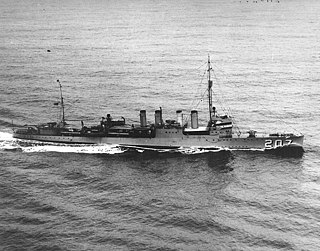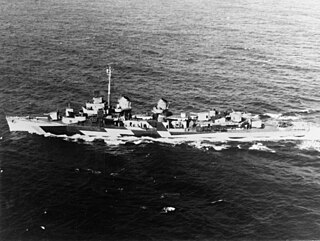
USS Mustin (DD-413) was a Sims-class destroyer of the United States Navy, the first Navy ship of that name, in honor of Captain Henry C. Mustin (1874–1923), a pioneer of naval aviation.

The third USS Farragut (DD-348) was named for Admiral David Glasgow Farragut (1801–1870). She was the lead ship of her class of destroyers in the United States Navy.

The fourth USS Dale (DD-353) was a Farragut-class destroyer in the United States Navy during World War II. Dale received 14 battle stars for World War II service. She was named for American Revolutionary war hero Richard Dale.

USS Abercrombie (DE-343) was a John C. Butler-class destroyer escort in the service of the United States Navy from 1944 to 1946. She was finally sunk as a target in 1968.

USS Vammen (DE-644) was a Buckley-class destroyer escort of the United States Navy.

USS Talbot (DD-114) was a Wickes-class destroyer in the United States Navy during World War I and later designated APD-7 in World War II. She was the first ship named in honor of Silas Talbot.

USS Southard (DD-207/DMS-10) was a Clemson-class destroyer in the United States Navy during World War II. She was the second Navy ship named for Secretary of the Navy Samuel L. Southard (1787–1842).

USS Twiggs (DD-591), a Fletcher-class destroyer, was the second ship of the United States Navy to be named for Marine Major Levi Twiggs (1793–1847).

USS Stanly (DD-478) was a Fletcher-class destroyer in service with the United States Navy from 1942 to 1947. She was scrapped in 1972.

USS Patterson (DD-392), a Bagley-class destroyer, was the second ship of the United States Navy to be named for Daniel Todd Patterson, an officer of the US Navy who served in the Quasi-War with France, First Barbary War, and the War of 1812.

USS Haggard (DD-555) was a Fletcher-class destroyer of the United States Navy named for Captain Haggard of the Louisa, who fought in the Quasi-War.

USS Harrison (DD-573) was a Fletcher-class destroyer of the United States Navy. She was second Navy ship of that name.

USS Sterett (DD-407) was a Benham-class destroyer in the United States Navy. She was the second Navy ship named for Andrew Sterett.

USS Halloran (DE-305) was a Evarts-class destroyer escort of the United States Navy.

The second USS Fleming (DE-32), and first ship of the name to enter service, was an Evarts-class destroyer escort built for the United States Navy during World War II. While performing convoy and escort duty in the Pacific Ocean she was also able to sink one Japanese submarine and to shoot down several kamikaze planes that intended to crash onto her. For her military prowess under battle conditions, she was awarded four battle stars.

USS Brackett (DE-41) was an Evarts-class destroyer escort of the United States Navy during World War II. She was sent off into the Pacific Ocean to protect convoys and other ships from Japanese submarines and fighter aircraft. She performed escort and anti-submarine operations in dangerous battle areas and was awarded three battle stars.

USS Seid (DE-256) was an Evarts-class destroyer escort of the United States Navy in service from 1943 to 1945. She was scrapped in 1947.

USS Finnegan (DE-307) was an Evarts-class destroyer escort constructed for the United States Navy during World War II. She was sent off into the Pacific Ocean to protect convoys and other ships from Japanese submarines and fighter aircraft. She performed escort and antisubmarine operations in dangerous battle areas and returned home with three well-earned battle stars.

USS Wesson (DE-184) was a Cannon-class destroyer escort built for the United States Navy during World War II. She served in the Pacific Ocean and provided escort service against submarine and air attack for Navy vessels and convoys. She returned home at war's end with a very respectable seven battle stars to her credit.

USS Silverstein (DE-534) was a John C. Butler-class destroyer escort in service with the United States Navy from 1944 to 1947 and from 1951 to 1958. She was sold for scrapping in 1973.




















